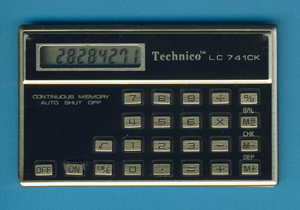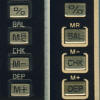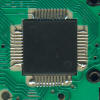
DATAMATH CALCULATOR MUSEUM
 |
DATAMATH CALCULATOR MUSEUM |
Technico LC-741CK
| Date of introduction: | 1982 | Display technology: | LCD |
| New price: | $10.00 (SRP Oct. 1982) | Display size: | 8 |
| Size: | 2.2" x 3.5" x
0.20" 55 x 90 x 5 mm3 |
||
| Weight: | 1.1 ounces, 33 grams | Serial No: | |
| Batteries: | 2*LR54 | Date of manufacture: | mth 12 year 1982 |
| AC-Adapter: | Origin of manufacture: | Taiwan | |
| Precision: | 8 | Integrated circuits: | |
| Memories: | 1 | ||
| Program steps: | Courtesy of: | Joerg Woerner |

![]() National Semiconductor introduced already in 1978 with the
NS103 Data Checker an electronic record keeper
with three continuous memories to track bank and charge account balances with
dedicated keys:
National Semiconductor introduced already in 1978 with the
NS103 Data Checker an electronic record keeper
with three continuous memories to track bank and charge account balances with
dedicated keys:
| • Memory 1 [CHK] [DEP] [BAL] [A] • Memory 2 [PMT] [CHG] [BAL] [B] • Memory 3 [PMT] [CHG] [BAL] [C] • Total sum of Memories [GT] |
While the NS103 Data Checker was based on proprietary technology, introduced NEC of Japan with the uPD1833G in 1980 a single-chip calculator circuit that created the blueprint for checkbook-sized Account Manager calculators and thereupon the market got swamped with products based on this design. The uPD1833G simplified the use of the memories by removing the redundant [A], [B], and [C] keys and replaced the inconvenient three-way power-switch of the NS103 Data Checker with two dedicated [ON] and [OFF] keys and a [DS] key to toggle between two entry modes:
| • Indicator (--) Floating decimal with manual insertion of the decimal using the [.] key • Indicator (AM) Add mode with the decimal automatically put in the dollars and cents position (0.00) |
Even the successor of the NS103, known as NS103A, switched its internals to the uPD1833G but we feature some more Account Manager calculators in the Datamath Calculator Museum based on this technology:
| • Canon
Checkbook - Missing the Toggle Key for the decimal mode • Royal LCB 841 - The Art of Perfection in Japan • Royal LCB 835 - Just one Memory (uPD1831G) • Texas Instruments TI-2200 Checkwriter - Late, but not too late • This Unisonic LC 262CK Check Master - Credit Card sized |
NEC of Japan lost some market share with their design for Account Manager calculators in the Eighties, when competitors like Hitachi and Sharp introduced similar chips and finally lost the business completely to Toshiba's "Solar Cells" compatible design. Find more Account Manager calculators in the Datamath Calculator Museum:
| • Canon
Checkbook II - Toshiba inside • Casio CB-80 - Hitachi inside • Unisonic LC 224CK Check Master - Sharp Inside • Texas Instruments TI-2200 II Checkwriter - Toshiba + Solar cells = Winning formula |

 Dismantling
the featured Technico LC-741CK manufactured in December 1982 by
Inventa Electronics Corporation in Taiwan reveals a clean design
centered around an unknown single-chip calculator circuit soldered on a
double-sided printed circuit board (PCB) and powered by
two small LR54 (LR1130) batteries.
Dismantling
the featured Technico LC-741CK manufactured in December 1982 by
Inventa Electronics Corporation in Taiwan reveals a clean design
centered around an unknown single-chip calculator circuit soldered on a
double-sided printed circuit board (PCB) and powered by
two small LR54 (LR1130) batteries.
 Inspecting the PCB of the
Technico LC-741K Checkbook Balancer brought our attention to a small mark
reading I074F-02B and we started compiling a list of
PCB-Marks found on
Checkbook Calculators. What we missed on the PCB are two small jumpers known
from both the similar APF Electronics 3552CK
Checkbook Balancer and Enterprex MC-2717 Checkbook Calculator to select between:
Inspecting the PCB of the
Technico LC-741K Checkbook Balancer brought our attention to a small mark
reading I074F-02B and we started compiling a list of
PCB-Marks found on
Checkbook Calculators. What we missed on the PCB are two small jumpers known
from both the similar APF Electronics 3552CK
Checkbook Balancer and Enterprex MC-2717 Checkbook Calculator to select between:
| • (MR) Checkbook Calculator: [BAL/MR] doesn't clear the Memory • (MRC) Standard Calculator: [MRC] does clear the Memory |
This interesting feature allows the use of the same PCB design for both "Standard" and "Checkbook" calculators.
 Missing this feature
results in a "Checkbook" Calculator with a unique [MRC] key - meaning if you
accidentally press the button twice your Balance is gone. Please compare the
keyboard of the Technico LC-741CK with an [MRC]
key with additional [BAL] lettering, while the APF Electronics 3552CK sports a
[BAL] key with additional [MR] lettering. Maybe it was just the Marketing
Department to upgrade the LC-74CK calculator to a
checkbook calculator...
Missing this feature
results in a "Checkbook" Calculator with a unique [MRC] key - meaning if you
accidentally press the button twice your Balance is gone. Please compare the
keyboard of the Technico LC-741CK with an [MRC]
key with additional [BAL] lettering, while the APF Electronics 3552CK sports a
[BAL] key with additional [MR] lettering. Maybe it was just the Marketing
Department to upgrade the LC-74CK calculator to a
checkbook calculator...
 Learn more about single-chip calculator circuits used in
Account
Manager Calculators.
Learn more about single-chip calculator circuits used in
Account
Manager Calculators.
Don't miss the Corvus CheckMaster
introduced by Mostek already in 1975. This rare product retains the balance of
your memory even when shut off but uses power-hungry electronics.
If you have additions to the above article please email: joerg@datamath.org.
© Joerg Woerner, March 26, 2020. No reprints without written permission.